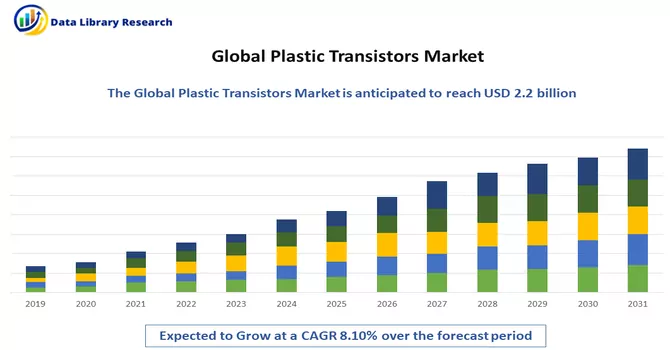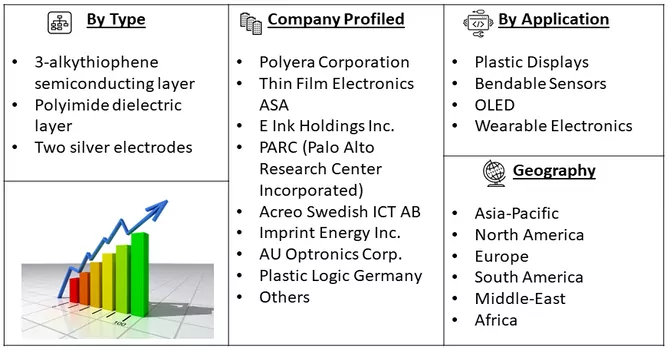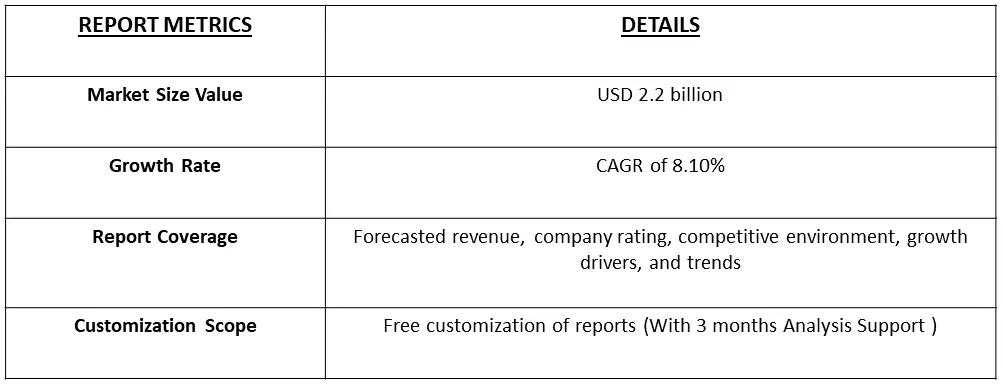The global plastic transistors market size was estimated at USD 2.2 billion in 2023 and is projected to hit a CAGR of 8.10% during the forecast period from 2024 to 2031.

Get Complete Analysis Of The Report - Download Free Sample PDF
Plastic transistors typically refer to transistors where the semiconductor material is made of organic polymers or plastic compounds instead of traditional inorganic materials like silicon. These organic transistors are also known as organic field-effect transistors (OFETs). Organic transistors have unique properties that make them suitable for certain applications, although they are not as common as silicon transistors in mainstream electronic devices. Plastic transistors use organic semiconductors, which are made from carbon-based compounds. These materials often have the advantage of being lightweight, flexible, and potentially lower in cost compared to traditional silicon-based transistors.
The factors that are driving the growth of the studied market are the growing demand for flexible and bendable electronic devices, such as flexible displays, wearable electronics, and foldable smartphones, is a significant driver for the plastic transistors market. Plastic transistors enable the development of flexible electronic components. The potential for lower manufacturing costs associated with plastic transistors, especially when compared to traditional silicon-based transistors, can be a driving factor. This cost-effectiveness may attract manufacturers looking for economical solutions for specific applications.
Market Segmentation: Plastic Transistors Market by Type (3-alkythiophene semiconducting layer, Polyimide dielectric layer, and Two silver electrodes), Application (Plastic Displays, Bendable Sensors, OLED, and Wearable Electronics) and Geography (North America, Europe, Asia-Pacific, and Rest of the World). The value is provided (in USD million) for the above segments.

For Detailed Market Segmentation - Download Free Sample PDF
The demand for flexible and bendable electronic devices continues to rise, driving the adoption of plastic transistors. The trend towards foldable smartphones, flexible displays, and wearable electronics contributes to the growth of the market. Furthermore, the ongoing research and development efforts focus on improving the properties of organic semiconductor materials used in plastic transistors. Advancements in materials lead to enhanced performance, such as improved conductivity, stability, and overall efficiency. Moreover, the proliferation of IoT devices across various industries drives the demand for compact and flexible electronic components, including plastic transistors. These transistors play a role in the development of sensors and other IoT-related devices.
Market Drivers:
Rising Demand for Bendable Tech and Boom in Electronic
Traditional electronics are characterized by rigid structures and components, limiting their application in various sectors. Bendable technology, on the other hand, leverages flexible materials and innovative designs to create devices that can be bent, curved, or even rolled up. This flexibility not only enhances user experience but also opens up new possibilities for applications in diverse industries. The demand for wearable devices such as smartwatches, fitness trackers, and health monitoring devices has soared. Bendable technology allows manufacturers to create comfortable and aesthetically pleasing wearables that conform to the contours of the human body. Also, an article published by The Hindu, in October 2023, reported that the electronics manufacturing market trend in India, the demand for apprentices in the sector witnessed a 93% growth during the fourth quarter of FY22–23, according to a report by TeamLease Degree Apprenticeship. The rollout of 5G networks and the continuous expansion of the Internet of Things (IoT) have created a robust ecosystem for interconnected devices. This has driven the demand for advanced electronics capable of handling higher data speeds and supporting the seamless integration of a multitude of devices. Thus, the market for plastic transistors is experiencing a boom as industries across the spectrum recognize the potential of this innovative component. Furthermore, ongoing research and development efforts are focused on further enhancing the performance, durability, and scalability of plastic transistors, ensuring their seamless integration into a wide range of electronic devices. Thus, such factors are expected to boost the studied market growth over the forecast period.
Advancements in Printed Electronics
Printed electronics have undergone remarkable advancements, ushering in a new era of innovation and flexibility in electronic device manufacturing. This transformative technology leverages printing techniques to create electronic components, such as transistors, sensors, and displays, on various substrates, including plastics and flexible materials. The continuous progress in printed electronics is unlocking possibilities for lightweight, cost-effective, and flexible electronic devices across diverse industries. Moreover, traditional electronics rely on rigid substrates like silicon, but printed electronics have introduced the use of flexible materials such as plastics, paper, and even textiles. This shift enables the production of lightweight and bendable devices, ranging from wearable electronics to flexible displays. Thus, the continuous advancements in printed electronics are propelling the industry towards a future where flexible, lightweight, and cost-effective electronic devices are the norm. As research and development efforts persist, further breakthroughs in materials, printing technologies, and applications are anticipated, solidifying the role of printed electronics in shaping the next generation of electronic devices across various sectors. Thus, owing to the above-mentioned factors, the market is expected to witness significant growth over the forecast period.
Market Restraints:
Performance Challenges and Durability Concerns
The plastic transistor market has witnessed significant attention and growth due to its potential to revolutionize the electronics industry with flexible and lightweight components. However, despite its promise, the market faces challenges related to performance limitations and durability concerns that may impede its rapid expansion. One of the primary challenges faced by plastic transistors is their limited electron mobility compared to traditional silicon transistors. This can result in slower electronic response times and reduced overall performance in terms of speed and efficiency. Plastic transistors may face challenges in maintaining stability in diverse environmental conditions. Exposure to humidity, extreme temperatures, or harsh chemicals can impact the structural integrity of plastic components, potentially leading to a decrease in device durability and reliability Thus, such factors are expected to slow down the growth of the studied market over the forecast period.
The COVID-19 pandemic has reverberated across industries, disrupting global supply chains, affecting consumer behaviours, and influencing market dynamics. The plastic transistor market, promising innovation and flexibility in electronics, has not been immune to the challenges posed by the pandemic. This analysis explores the multifaceted impact of COVID-19 on the plastic transistors market, considering both short-term disruptions and long-term implications. The pandemic-induced lockdowns, restrictions, and transportation disruptions significantly impacted global supply chains. Manufacturers of plastic transistors faced challenges in sourcing raw materials, and components, and maintaining production continuity, leading to delays and shortages in the supply chain. The pandemic has heightened awareness of environmental and sustainability concerns. The plastic transistor market may witness increased investment in sustainable materials and manufacturing processes, aligning with global initiatives for eco-friendly electronics. Thus, the COVID-19 pandemic introduced short-term disruptions and challenges to the plastic transistor market, it also paved the way for long-term opportunities and adaptation.
Segmental Analysis:
Polyimide dielectric layer Segment is Expected to Witness Significant Growth over the Forecast Period
Polyimide dielectric layers have emerged as a crucial component in the development of plastic transistors, playing a pivotal role in enhancing their performance and expanding their applications. As the demand for flexible and lightweight electronic devices grows, the synergy between polyimide dielectric layers and plastic transistors becomes increasingly significant. This discussion delves into the characteristics, applications, and advantages of polyimide dielectric layers in the context of plastic transistors. Polyimide dielectric layers enable the creation of flexible and bendable transistors. This flexibility is particularly beneficial for applications in wearable devices, foldable displays, and other electronics requiring adaptable form factors. Polyimide exhibits low surface roughness, which is crucial for maintaining uniformity in thin film deposition processes. This characteristic enhances the precision and reliability of the transistor's performance. The dielectric strength of polyimide is high, preventing electrical breakdown and ensuring the reliable operation of transistors even under challenging conditions. Polyimide is resistant to various chemicals, offering protection against environmental factors that might compromise the integrity of the transistor. Thus, owing to such advantages, the segment is expected to witness significant growth over the forecast period.
Plastic Display Segment is Expected to Witness Significant Growth Over the Forecast Period
The convergence of plastic displays and plastic transistors has given rise to a transformative synergy, paving the way for a new era in flexible and lightweight electronics. As consumer preferences increasingly lean towards portable and adaptable devices, the market for plastic displays and plastic transistors is experiencing remarkable growth. This discussion explores the interplay between these two technologies, their applications, and the market trends shaping their trajectory. Plastic displays, typically made from flexible organic materials, offer unparalleled flexibility compared to traditional rigid screens. This flexibility allows for the creation of curved, foldable, and even rollable display panels. Plastic displays are prominently featured in smartphones, smartwatches, and e-readers, providing a more immersive and aesthetically pleasing user experience. The convergence of plastic displays and plastic transistors is catalyzing a paradigm shift in the electronics industry. As these technologies mature, their applications are diversifying, from everyday consumer devices to specialized industrial and healthcare applications. The market for plastic displays and plastic transistors is poised for sustained growth, driven by innovations that promise to redefine the landscape of flexible and adaptable electronic devices. Thus, owing to such factors, the segment is expected to witness significant growth over the forecast period.
Asia Pacific Region is Expected to Witness Significant Growth Over the Forecast Period
The Asia Pacific region has emerged as a dynamic hub for technological innovation and market expansion, with the plastic transistors market experiencing significant growth in recent years. The combination of robust manufacturing capabilities, a burgeoning consumer electronics market, and a focus on research and development positions the Asia Pacific region at the forefront of the plastic transistors industry. The demand for electronic devices in the Asia Pacific region, driven by a tech-savvy population and a growing middle class, creates a significant market for plastic transistors used in the production of flexible and lightweight electronic components.
Furthermore, countries like Japan and South Korea boast world-class research and development facilities, fostering innovation in materials science, electronics, and semiconductor technologies. This commitment to innovation has accelerated advancements in plastic transistors, making the Asia Pacific region a hotbed for cutting-edge research. For instance, in October 2023, engineers from South Korea and the United States announced the successful development of a low-voltage flexible transistor, a breakthrough that could pave the way for the creation of wearable devices such as wristwatches mobile phones and computers that can be worn like clothing. Transistors, essential components for amplifying electric signals in semiconductors, have been a focus of engineers aiming to manufacture flexible versions in recent years, according to the Korea Institute of Science and Technology (KIST). The collaborative effort by South Korean and U.S. engineers marks a significant step forward in achieving this goal. Thus, such developments are expected to boost the studied market’s growth over the forecast period.
Thus, the Asia Pacific region stands as a pivotal force in the expansion of the plastic transistors market, driven by its robust electronics industry, manufacturing prowess, innovation ecosystems, and consumer-driven demand for cutting-edge devices. As the region continues to lead in research and development, manufacturing capabilities, and market influence, it is poised to shape the future of the plastic transistors industry and contribute significantly to the ongoing evolution of flexible and lightweight electronics worldwide.

Get Complete Analysis Of The Report - Download Free Sample PDF
The key market players involved in the development and manufacturing of plastic transistors include both established companies and research institutions that contribute to advancements in organic electronics. The companies involved in this market segment focus on The company focus on developing materials and technologies that enable the fabrication of flexible transistors for various applications. These players contribute to the research, development, and commercialization of plastic transistors, playing a crucial role in advancing the field of organic electronics. Plastic Transistors Market Players:
Recent Development:
1) In 2023; Researchers at Northwestern University introduced a groundbreaking technology capable of amplifying signals by over 1,000 times. Unlike traditional methods that rely on complex and bulky electronics, this innovative approach utilizes transistors, the fundamental building blocks of electronics, to significantly enhance weak signals. The breakthrough enables the detection of signals with greater ease, particularly in the realm of weak biochemical signals. This advancement marks a significant stride in modern medicine, moving us closer to achieving real-time, on-site diagnostics, and improved disease monitoring capabilities.
2) In May 2019, the acquisition of Microsemi by Microchip Technology had a profound impact on the transistor market. Microchip Technology, headquartered in the United States, has substantially broadened its range of transistors through this strategic move, solidifying its standing in the industry. This acquisition not only fortifies the company's capacity to address a wide array of market requirements but also positions it strategically for future growth and innovation within the dynamically changing semiconductor landscape.
Q1. What was the Plastic Transistors Market size in 2023?
As per Data Library Research the global plastic transistors market size was estimated at USD 2.2 billion in 2023.
Q2. At what CAGR is the Plastic Transistors market projected to grow within the forecast period?
Plastic Transistors market is projected to hit a CAGR of 8.10% during the forecast period.
Q3. What are the factors driving the Plastic Transistors market?
Key factors that are driving the growth include the Rising Demand for Bendable Tech and Boom in Electronic and Advancements in Printed Electronics.
Q4. Which region has the largest share of the Plastic Transistors market? What are the largest region's market size and growth rate?
Asia Pacific region has the largest share of the market . For detailed insights on the largest region's market size and growth rate request a sample here.
Data Library Research are conducted by industry experts who offer insight on industry structure, market segmentations technology assessment and competitive landscape (CL), and penetration, as well as on emerging trends. Their analysis is based on primary interviews (~ 80%) and secondary research (~ 20%) as well as years of professional expertise in their respective industries. Adding to this, by analysing historical trends and current market positions, our analysts predict where the market will be headed for the next five years. Furthermore, the varying trends of segment & categories geographically presented are also studied and the estimated based on the primary & secondary research.
In this particular report from the supply side Data Library Research has conducted primary surveys (interviews) with the key level executives (VP, CEO’s, Marketing Director, Business Development Manager and SOFT) of the companies that active & prominent as well as the midsized organization
FIGURE 1: DLR RESEARH PROCESS

Extensive primary research was conducted to gain a deeper insight of the market and industry performance. The analysis is based on both primary and secondary research as well as years of professional expertise in the respective industries.
In addition to analysing current and historical trends, our analysts predict where the market is headed over the next five years.
It varies by segment for these categories geographically presented in the list of market tables. Speaking about this particular report we have conducted primary surveys (interviews) with the key level executives (VP, CEO’s, Marketing Director, Business Development Manager and many more) of the major players active in the market.
Secondary ResearchSecondary research was mainly used to collect and identify information useful for the extensive, technical, market-oriented, and Friend’s study of the Global Extra Neutral Alcohol. It was also used to obtain key information about major players, market classification and segmentation according to the industry trends, geographical markets, and developments related to the market and technology perspectives. For this study, analysts have gathered information from various credible sources, such as annual reports, sec filings, journals, white papers, SOFT presentations, and company web sites.
Market Size EstimationBoth, top-down and bottom-up approaches were used to estimate and validate the size of the Global market and to estimate the size of various other dependent submarkets in the overall Extra Neutral Alcohol. The key players in the market were identified through secondary research and their market contributions in the respective geographies were determined through primary and secondary research.
Forecast Model
